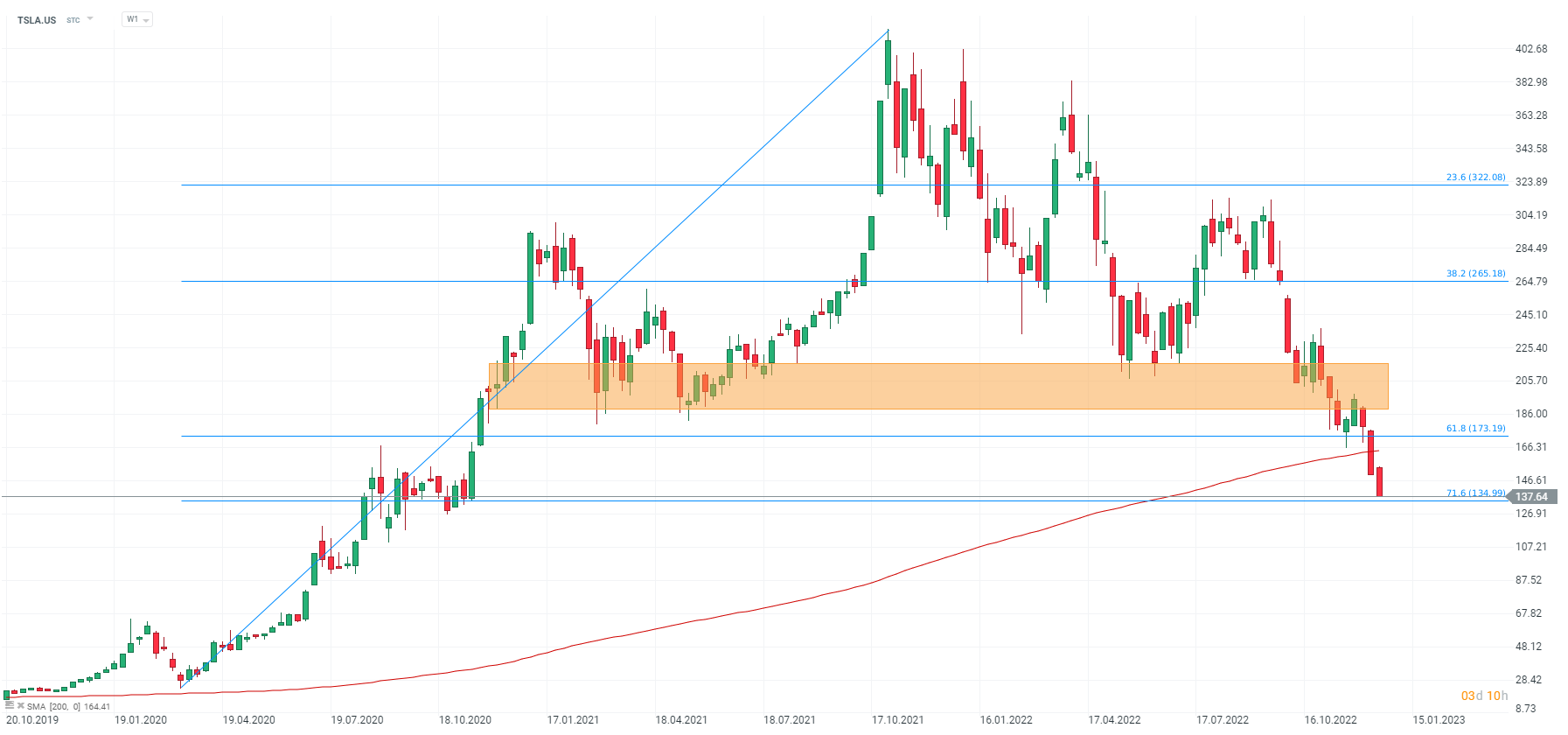According to reports from the Electrek portal, Tesla will stop employment and is preparing for another wave of employee layoffs due to gloomy macroeconomic prospects and rising energy prices, which may limit the demand for electric cars. Tesla shares fell nearly 8% yesterday to a 52-week low. Today, before the opening of the session, they are listed slightly higher because the shareholders positively perceived the planned cost cutting in the uncertain economic environment.
What caused the sell-off
According to Elon Musk, the change in macroeconomic factors negatively affected share prices. Some critics, however point out that the market began to doubt whether company will continue to expand as Musk, who considered as a 'guarantee of success and the main driving force of Tesla', devoted himself excessively to Twitter, where he will soon resign as CEO as a result of a survey among the portal's community. Shareholders' pessimism has deepened after Musk sold subsequent stake in Tesla, the last of which amounting to a total of USD 3.6 billion was liquidated last week. Earlier this year, the billionaire promised not to sell his shares.
Tesla is trying to offer attractive discounts and is creating a marketing campaign in China to boost sales. Vehicles are delivered to the Chinese market straight from the factory in Shanghai, where the production of flagship Y models will be shut down in the last week of December. Reuters was unable to determine the cause of Tesla's planned shutdown. The company is trying to improve the efficiency of its factories in Texas and Germany, is struggling with supply chain problems and rising energy costs in Europe, which may affect the condition of the recently commissioned gigafactory near Berlin. Taking into account deteriorating macro forecasts and weakening consumer demand, analysts Evercore ISI and Mizuho Securities lowered their recommendation for Tesla yesterday, which weighed on shareholders sentiment. It is worth noting that Tesla shares from the fundamental side were highly valued throughout nearly the entire 2022, and their price-to-earnings and price-to-book ratios still show that Wall Street has excessive expectations from the electric car manufacturer, much higher than the index average for NASDAQ and S&P 500.
Is the situation really that bad?
Looking at the company's new factories and very successful financial results for the third quarter of 2022, it is possible that Tesla will maintain its competitive advantage in the long term, while new tax credits for electric vehicles in the US may accelerate demand in the country. The Chinese consumer looks a little worse, who is struggling with much bigger problems this year, which may also be one of the reasons for Tesla's strong sales campaign in the world's second largest economy. According to Joshua White, formerly an economist working at the Securities and Exchange Commission, high interest rates are only partially responsible for the recent sell-off, perhaps the most important component of which is Twitter and the related change in the perception of Elon Musk as CEO, who begins to neglect the company and gets rid of her shares. Tesla's share price has fallen over 65% since the beginning of the year and its capitalization is now lower than ExxonMobil, while at the peak of the 2021 bull market Tesla capitalization was several times higher than the oil giant. This makes the shares of Elon Musk's company one of the 'biggest losers' this year, next to Mark Zuckerberg and his company Meta Platforms, which was hit by the slowdown in the advertising market and the growing controversy among market regulators. Next year could be at least as difficult for the company as 2022, and Wall Street could be forced to significantly lower its expectations.
 Tesla (TSLA.US), W1 interval. Tesla's share price fell below the 200 session average on a weekly basis, signaling a trend reversal. However, the sell-off stopped around 71.6% of the Fibonacci retracement of the upward wave that started in April 2020. The chart also shows a head-and-shoulders pattern, and one can notice that sell-off intensified after sellers managed to push the price below the neckline, around $200 per share. Source: xStation5
Tesla (TSLA.US), W1 interval. Tesla's share price fell below the 200 session average on a weekly basis, signaling a trend reversal. However, the sell-off stopped around 71.6% of the Fibonacci retracement of the upward wave that started in April 2020. The chart also shows a head-and-shoulders pattern, and one can notice that sell-off intensified after sellers managed to push the price below the neckline, around $200 per share. Source: xStation5
Stock of the week - Micron Technology (18.12.2025)
A tale of three central banks
The Global Chip Cold War. How China is Changing the Rules of Technology
D day for the BOE, as central banks take centre stage
This content has been created by XTB S.A. This service is provided by XTB S.A., with its registered office in Warsaw, at Prosta 67, 00-838 Warsaw, Poland, entered in the register of entrepreneurs of the National Court Register (Krajowy Rejestr Sądowy) conducted by District Court for the Capital City of Warsaw, XII Commercial Division of the National Court Register under KRS number 0000217580, REGON number 015803782 and Tax Identification Number (NIP) 527-24-43-955, with the fully paid up share capital in the amount of PLN 5.869.181,75. XTB S.A. conducts brokerage activities on the basis of the license granted by Polish Securities and Exchange Commission on 8th November 2005 No. DDM-M-4021-57-1/2005 and is supervised by Polish Supervision Authority.


